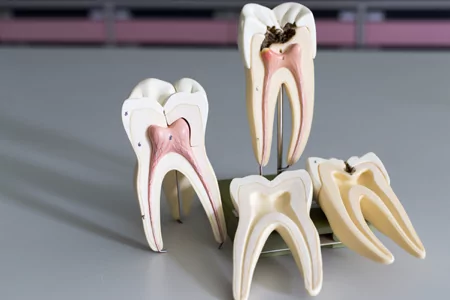
Sometimes it takes more than great dental habits and regular visits to keep your teeth healthy and whole. There are times when dental procedures such as root canal therapy are essential.
This procedure has a bad reputation; but in reality, most root canal patients experience long-term relief! So, let’s get down to the facts of root canals—and bring comfort to those who are anticipating needing one.
What Is a Root Canal?
To understand why root canal treatment is scary to some people, it’s important to look at what a root canal is.
The “root canal” is the term for the center of each tooth where the vulnerable pulp and the central nerve of each tooth reside. But the term is also used commonly to refer to root canal treatment or root canal therapy, which is a dental procedure in which the nerve and pulp of a tooth is removed.
That certainly does sound unpleasant! But it’s a treatment option that’s employed in order to repair and ultimately save a tooth that has been damaged by decay or trauma.
When Does Someone Need a Root Canal?
Root canal treatments aren’t meant to be administered all willy-nilly! This procedure is used to remove a damaged or infected nerve from the tooth, saving the tooth structure and saving the patient from a great deal of pain.
The most common reasons that a person may need a root canal treatment include:
- Severe tooth decay that penetrates the delicate inside of the tooth, or an abscess or infection from decay
- Trauma—such as cracking or breaking a tooth—that results in an exposed nerve
- A tooth dying due to prior trauma or infection that was left untreated
What Happens During a Root Canal?
Once it’s been determined that a root canal treatment is the right choice for keeping a patient’s teeth healthy, it’s time to schedule the actual procedure! Here’s what to expect if you’re having a root canal done:
First, the dentist will numb the affected area using Novocain. For cases of extreme sensitivity or anxiety, other sedation techniques may be used.
Once the area is numbed, the dentist places a small sheet of rubber or latex around the tooth in order to isolate it. This helps to keep saliva and debris from entering the exposed inner tooth while the dentist is working.
Next, the real work begins! The dentist starts by using a drill to create an opening to the tooth’s nerve space. Because the patient has been numbed or sedated, this won’t hurt.
After this, the tooth and the inner canals are examined and measured for complete accuracy for the next part of the procedure: cleaning and shaping. The dentist carefully extracts all nerve tissue and any bacteria or debris from within the tooth and then shapes the remaining space so that it’s ideal for filling in.
Finally, the dentist fills in the affected space and seals it. Sometimes, it’s necessary to use a temporary filling and make a second appointment for a permanent crown.
Do you have more questions about root canal therapy or other dental treatments and services? Feel free to reach out to Almeida & Bell Dentistry via our website or call (720) 428-2891













